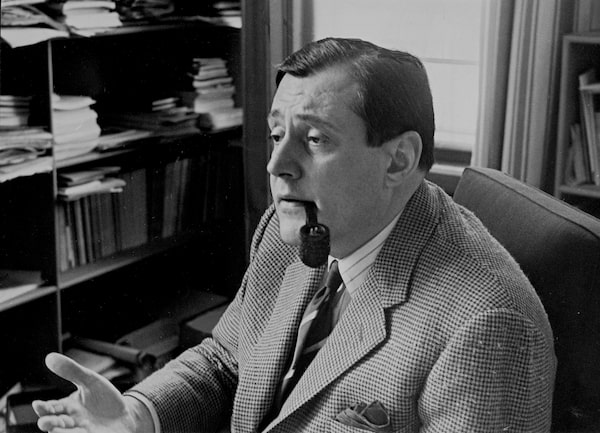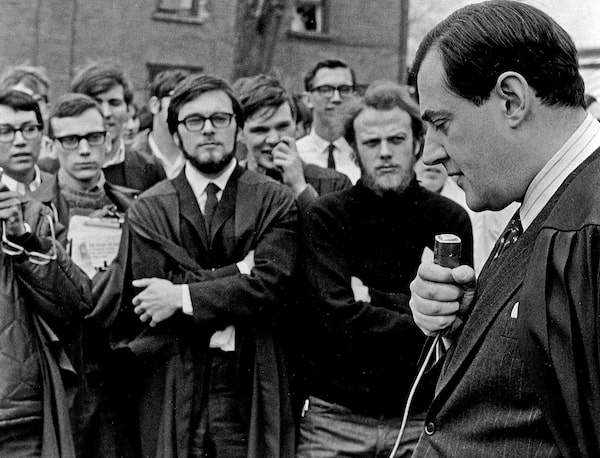
Thomas Henry Bull Symons, president of Trent University, sitting in his office, May 23, 1968.Handout
Thomas Henry Bull Symons was internationally renowned as a distinguished professor and author in Canadian Studies and academic administrator. One of his crowning achievements was helping found Trent University in Peterborough, Ont. It opened its doors to its first 102 students in the 1964-65 academic year. Prof. Symons served for 11 years as Trent’s first president and vice-chancellor. His biographer describes Prof. Symons as “one of Canada’s pre-eminent educational and cultural statesmen of the 20th century.”
“Tom was a builder,” says Canadian ambassador to the United Nations Bob Rae of Prof. Symons, who died at home on Jan. 1 at the age of 91. “He was a unique figure in our country because he had a vital interest and impact on so many areas – higher education, heritage, the environment, Indigenous Studies and understanding Canada. To me he was the progenitor of Canadian Studies. He just built things.”
Former prime minister Paul Martin was a second-year history student at the University of Toronto when he first met Prof. Symons. “He led a small discussion group which everybody wanted to belong to because quite simply he made history live,” Mr. Martin said. “In the years that followed we became good friends and when I began to pursue my interest in Indigenous matters, Tom’s work at Trent University stood out for me as an example of what should be done. We will all miss him.”
In May, 2019, Ontario Lieutenant-Governor Elizabeth Dowdeswell joined dignitaries from the Peterborough area and more than 400 students, alumni, friends, family and community leaders to celebrate Prof. Symons’s 90th birthday.
Ms. Dowdeswell befriended Prof. Symons decades ago and would often visit with him and his wife at Marchbanks, their home in Peterborough. “Every time I drove to Ottawa I would try to stop on the way to have a cup of tea with him and Christine,” she said. “I walked into that lovely house, just full of books, fire burning, and we would have a rich conversation. He was a beacon of intellectual light and Canadian scholarship. You’d always leave feeling enriched by the experience.”
After hearing of his death, Ms. Dowdeswell tweeted, “He loved this country and brought this love to the world. His legacy is an inspiration and his contributions will continue to benefit all those who seek understanding and who ask the great Canadian questions.”

Prof. Symons with students during a demonstration in 1968.Trent University Library and Archives
Former students describe how Prof. Symons would introduce himself to them on campus, knowing their names without ever having met them. Apparently each year he memorized names, photographs and some pertinent information about members of the incoming class. Such behaviour fit his highly personalized model of pedagogy and student culture at Trent – the little “Oxford on the Otonabee” as it was called in the early days.
Says current Trent president Leo Groarke, “I believe he knew he could foster that culture through his own example and words, showing that he cared and was prepared to do the background research and study.”
Speaking at the 90th birthday celebration, former student Stu Butts used a metaphor of a honey bee to describe Prof. Symons’s impact on postsecondary education in Canada and beyond.
“As a scholar, educator, instigator, collaborator, pollinator, and friend, Tom has brought life and sustenance to an untold number of associations, organizations, institutions, and endeavours. We are proud of the fact that we have been able to keep our ‘bee’ at Trent, in Peterborough, while at the same time sharing him with the world.”
Trent University was created after a committee of Peterborough citizens approached Prof. Symons in 1961 while he was a dean at the University of Toronto. The citizens wanted Prof. Symons to lead a campaign to create a university in their city. Prof. Symons embraced the opportunity.
“The organization of the university and its general character is a pretty pronounced departure from the current trend in higher education in Canada and still more in the United States,” Prof. Symons told CBC Radio in 1969.
“At a time when higher education is moving toward mass production, huge institutions, huge classes, and depersonalization of the whole process of higher education, this university is moving in the other direction. [We want] as small classes as we can possibly manage, toward as much opportunity as possible for faculty and students to know one another and work together, and toward the best possible opportunities for the individual student to develop in an individual way.”
Prof. Symons feared institutions of higher education, including his beloved University of Toronto, were becoming akin to “impersonal factories” where an “academic elephantiasis” of unchecked growth diminished the educational experience.
With Prof. Symons as president, Trent University created Canada’s first Indigenous Studies program, followed by the Canadian Studies program and the Journal of Canadian Studies. Interdisciplinary learning in the liberal arts and sciences is a defining quality of Trent. Prof. Symons said it was England’s Durham University that helped inspire Trent’s federation of small, interdisciplinary colleges.
Prof. Symons viewed Trent as his baby and remained active in campus life until his death. Several of Trent’s subsequent presidents report that he continued to express his views forcefully to them on various matters such as campus architecture, his beloved college system and the university’s strategy, whether these views were solicited or not.
After graduating from the University of Toronto (B.A. 1951), Prof. Symons attended Oriel College, at Oxford (B.A. 1953, M.A. 1957). Prof. Symons returned to the University of Toronto where he was a tutor in history at Trinity College, 1953-55, and then dean of Devonshire House, University of Toronto, 1955-63.
Prof. Symons was Trent’s president and vice-chancellor until 1972, and in 1979, he was named the Vanier Professor. Upon retirement in 1994, he was made Vanier Professor Emeritus, and a Trent campus was renamed after him.
In the early 1970s, Prof. Symons led a national commission on Canadian Studies. The commission’s report, titled “To Know Ourselves,” was widely praised and inspired many scholars.
In 1976, he became a member of the Order of Canada (later promoted to companion, the order’s highest level) and he was elected as a fellow of the Royal Society of Canada in 1977.
Prof. Symons was awarded the Order of Ontario in 2002, in part, recognizing his contribution to the province by mediating high-profile French-language disputes in Sturgeon Falls in 1971, and in Cornwall in 1973. From the funds he received for this work, he set up the annual Symons Award for Excellence in Teaching, which continues to honour the best instructors at Trent University.
As Ontario’s Commissioner of Human Rights from 1975 to 1978, he helped lead major advancements, particularly for the LGBT community.
Prof. Symons served on the boards of various corporations, including being chair of the Social Responsibility Committee at Celanese Canada Inc. Prof. Symons also had a long working relationship with Czech-born shoe company owner Thomas J. Bata, with whom he worked closely during Trent University’s early years.
Internationally, Prof. Symons was chairman of the Association of Commonwealth Universities and chair of the International Board and vice-president of the International Council of United World Colleges. In 1982, Prof. Symons was the first Canadian to receive the Distinguished Service to Education Award of the globe-spanning Council for the Advancement and Support of Education.
Prof. Symons received 13 honorary degrees from Canadian universities and colleges, and he played a role in the founding of more than a dozen other colleges and universities. His work in the creation of Peterborough’s Sacred Heart College resulted in a knighthood from the Vatican.
One incident illustrated the deep affection Prof. Symons inspired everywhere he went. The late 1960s were a time of campus protest across North America. Trent had its first demonstration in March, 1968, and Prof. Symons, then the university’s president, was the target.
But there was a twist. A group of students learned that Prof. Symons had been approached by the Conservative Party in Ottawa to take on a new major political role in Canada. More than 375 of Trent’s 750 students demonstrated outside the president’s office, encouraging him to stay at Trent. Signs read “Keep the President Resident” and “Oh no please don’t go.” One of the student organizers, Stephen Stohn (now Trent’s chancellor), says: “We wanted him to know how much we appreciated his vision for the university and admired him personally.”
Prof. Symons declined the Ottawa opportunity and served on as Trent president for another five years, although he did become chair of a new Conservative Party initiative, the National Policy Advisory Committee.
Thomas Henry Bull Symons was born in Toronto on May 30, 1929, son of First World War flying ace Harry Lutz Symons and the former Dorothy Bull, daughter of the financier and historian William Perkins Bull. He married Christine Ryerson on Aug. 17, 1963 and leaves her, as well as his children, Mary, Ryerson and Jeffrey; and grandchildren, Wilson, Leighton, Ava, Charlotte and Olivia.